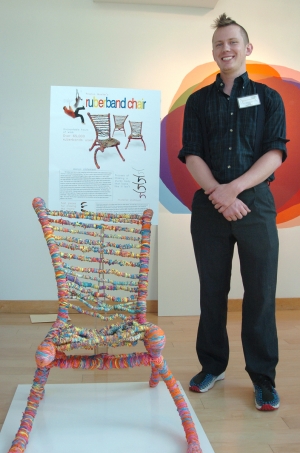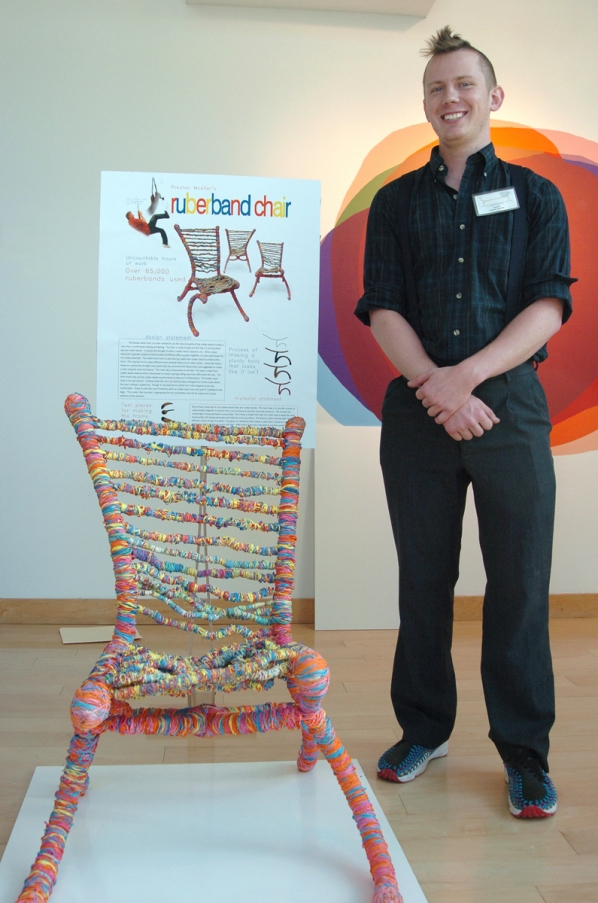BOONE—A chair constructed of 65,000 rubber bands took first place in the 6th Annual Chair Design Competition at Appalachian State University. Sponsored by the Department of Technology and Environmental Design, the competition finals were comprised of chairs constructed with wood, Corian, fabric and wood. Three universities and two community colleges were represented the competition.
The theme for this year’s competition was “Sitting on the Edge,” and encouraged student designers to explore the use of nontraditional materials and design. They were encouraged to push the boundaries and look past preconceived notions of the chair, the materials, and methods used to construct them.
A gallery of the photos can be seen here.

Preston Moeller’s design did just that. The senior industrial design major from Appalachian wrapped rubber bands around steel rods and pipe insulation to create a chair that was comfortable, colorful and quirky. As first place winner, Moeller received a check for $3,000.
Second place and a $2,000 prize went to Ethan Creasman for his chair made from polyethylene terephthalate (PETE), a polymer resin used to manufacture synthetic fibers, and beverage, liquid and food containers. Creasman is a junior industrial design major at Appalachian.
Third place and $1,000 was awarded to Justin A. Ellis from Western Piedmont Community College for his design made with twisted wood.
A rubber band ball inspired Moeller’s design. He said he made the chair to look and feel like it was 100 percent constructed from rubber bands. “This chair has a unique springy sitting area that softly holds the user,” he wrote in his designer’s statement. “The form mimics the pull the rubber bands would achieve as they pull on themselves. The rubber band chair is fun and colorful. It almost looks like a fun toy that has been enlarged to a human scale where the user is sitting in a giant toy. Though it may look like it is all for fun, it also happens to be very comfortable.”
Bob Williams, co-founder, executive vice president and director of design at Mitchell Gold + Bob Williams, called Moeller’s design a great example of taking an everyday material and using it in a way people wouldn’t normally consider.
Creasman cut pieces of polyethylene terephthalate, molded them with heat, and bound them together with binding screws and bolts.
Todd Campbell, design director for Bernhardt Design, was one of the judges for the competition. “We were enamored by how students took materials that were not necessarily made for furniture and created a design that is both unique and functional and makes a statement about design,” he said of Creasman’s and other students’ designs. “Design today for all of us is about how do we make a statement and still make it useable, and how do we push the boundaries and still make it safe. Those were some of the aspects we really appreciated in this (Creasman’s) chair,” he said.
Ellis’s chair was hand carved from cherry and maple wood. He said the design was inspired by natural occurring spirals in trees. While Ellis’s design was the most traditional of those in the competition, Andrew Glasgow praised Ellis’s attention to detail and his use of materials. Glasgow is former executive director of the American Craft Council and The Furniture Society.
This is the first year the competition was open to students other than those from Appalachian. Other schools with finalists in the competition were UNC Greensboro, N.C. State University and Haywood Community College.
The chairs will remain on display at the Turchin Center for the Visual Arts on campus through May 27.

